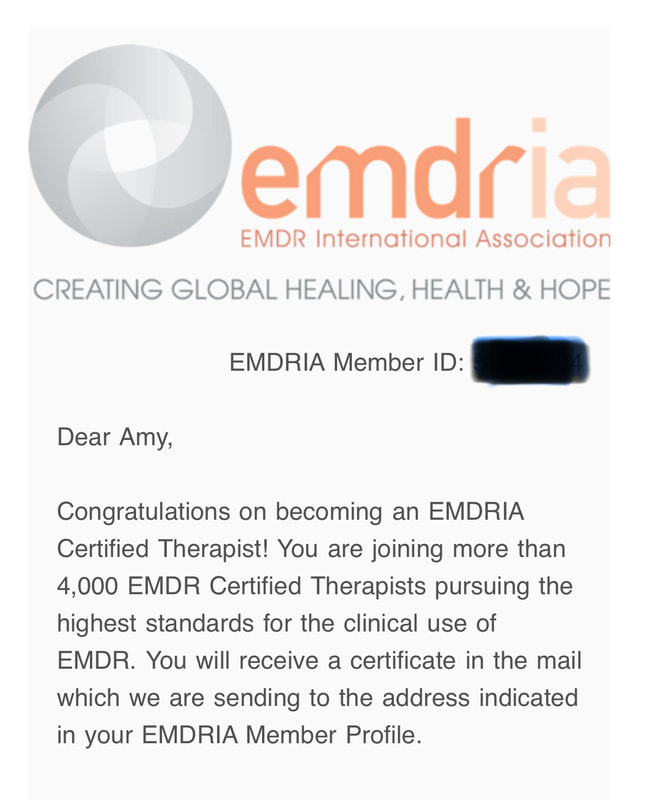|
So excited to announce that after two years of intensive training, I have been approved for certification as a Certified EMDR therapist!
What is the difference between EMDR trained and Certified? Clients will ask me, "what does it mean if I read that a therapist says he or she is Level 1 or Level 2 trained?". Generally speaking, EMDR basic trainings require a minimum of six days and a majority of EMDR trainings will break up the six day requirement by hosting two-three day weekend training events held on different assigned weekends of a specific month. When a clinician will state that he or she is "LEVEL 1 EMDR Trained", he or she has technically only completed the first three days of basic training. Subsequently, when a clinician states he or she is "LEVEL 2 EMDR Trained", he or she has completed the six days of basic training. Some therapists may find the basic training to be sufficient for what he or she is looking to add to his or her own practice. Once I completed basic training I immediately began applying the skills I learned and provided EMDR therapy in my sessions. I began to notice that my clients symptoms began to resolve almost immediately. How cool is that? People feeling better? I was hooked! After completing basic training I was presented the opportunity to invest in furthering my knowledge of EMDR treatment even more and I went for it! I dedicated the next two years of my life utilizing EMDR and somatic processing in my sessions, attending monthly meetings with an EMDRIA approved consultant for case consultation, and learning even more about the history, mechanism of action, and function of EMDR. In my down time I spent hours studying the limbic system, neurobiology of trauma, and human anatomy so that I could truly understand the biology of stress on a cellular level. My training and certification was unique in that the founder of the Somatic Attachment Focused EMDR protocol (S.A.F.E) interweaved a concept of noticing and understanding how the body will tell us what the client needs and how a feeling, movement, or overall posture may be linked to the emotion(s) associated with a disturbing memory. Being an EMDR provider requires a great depth of understanding and dedication to understanding how the human body reacts to stress, perceived danger, and how to work with a client when he or she may be beyond a window of tolerance to keep him or her safe. As a Certified EMDR therapist, part of my intensive training focused primarily on safety. This type of treatment necessitates a high level of competency and should not be used as a treatment unless the clinician has the qualifications, experience, and training to do so. I understand the necessity of keeping my clients safe and closely monitor each session, ensuring a person does not leave the session until he or she feels grounded enough to do so. So what's next? I look forward to continuing to utilize EMDR in my practice and would like to become an EMDRIA approved consultant. As a consultant, I would have the privilege of working with mental health professionals in the field who are interested in deepening his or her understanding of EMDR treatment. Regardless, the journey is far from over! If you have any questions regarding EMDR, Certification in EMDR, or would like to make an appointment, please feel free to give me a call: 904-280-8006 Hope you are having a great week so far. Regardless if you are struggling or like Lil' Duval says, "living your best life", use this moment to take a step back, pause, and try to view your situation the way you would look at a painting in a museum.
Sometimes we can get so involved and caught up in our own story that we can forget to take a step back and see the bigger picture. If you are at an art museum and come across a painting, you might go over to the canvas and inspect the painting from a close up angle. However, I doubt you could truly appreciate the piece of art just by studying it nose to canvas. In that case, you would be likely to take a step back and look at the painting as a whole and allowing whatever thought or emotion to surface as you stand and look at it from a distance. Why not do the same for your own story? Taking a moment to pause, reflect, and appreciate just how far you have come isn't selfish. Gratitude is a nutrient that helps nourish the soul. *Ezekiel Elliot feed me motion* Grief is not a linear process. Grief changes the various ways we make sense of our world with one less important person in it. When I encounter things such as these John Lennon stamps, I don't think back to the Beatles themselves. My thoughts take me back to warm memories of a beloved best friend and our connection that was founded on the Beatles and their music and I am so grateful for receiving this random yet powerful reminder of her. Find what soothes you and connect to that. Find refuse in your memories.
Do not let fear steer the wheel of your life decisions. You can accomplish a lot more looking at things through the lens of love rather than the lens of fear. Once we can acknowledge we are saying no with love instead of saying yes with fear, setting boundaries could become a lot less painful for some. Have a great start to your week!
Generally speaking, Cognitive Behavioral Therapy (CBT) works by breaking down the thoughts, images, beliefs and attitudes and how these processes relate to how a person behaves (and emotionally responds).
. . Let’s look at this model from a different lens, or a somatic lens: you experience an event your BODY responds with a feeling (e.g danger, fear, excitement, happiness, pain) feeling gets translated into thought/opinion/memory (e.g Is it safe? Is it going to be painful? Can I get hurt from it? Maybe I should post that selfie to show my ex how I’m thriving) you respond and go from there (aka your behavior) . . . What’s my point? I hear A LOT of horror stories of folks having their feelings invalidated. Your feelings are so important. YOU are important. And when you are able to identify what you FEEL you can identify the thought and if you can do that, you can do ANYTHING. Today we will go a little deeper in trauma. Dr. Stephen Porges developed Polyvagal theory to expand our understanding of how the nervous system responds to threat and trauma.
In our last post we briefly talked about the nervous system and it's role in trauma. Dr. Porges added a third factor: the vagus nerve. The vagal nerve plays a role in regulating the heart, face, stomach, and breath. The nerve also communicates with the brain. When talking about the nervous system, we will need to use some anatomical terms to orient ourselves: Ventral: towards the front of the torso. The navel (belly button) is on the ventral or anterior part of the body. Dorsal: towards the back of the torso. For example, the shoulder blades are dorsal or posterior to the ribs. The vagus nerve, or more specifically the ventral branch of the vagus nerve, controls the muscles of the face. The face, heart, and lungs are all used when we interact with others (e.g. smiling or making eye contact, feeling our heart beating faster, using our lungs to speak and breathe). This is what Dr. Porges calls "social engagement". In other words, it is through our face, heart, and brain connection that we learn to respond to interpersonal threats and challenges. Let's use a worst-case scenario as an example of how this works. Imagine this: you are walking down a dark alley alone and you see a dark shadow in the distance approaching you. Your face (eyes, nose, and ears) capture the image, hear the footsteps, and smell any scents or aromas in the air. Your brain takes in all the information your sensory organs are sending and tries to make sense of the shadowy figure. As this takes place, your heart begins pumping a lot harder to disperse blood flow to your muscles just in case you need to fight or make a run for it (flee/flight) from this unfamiliar and potentially dangerous shadowy figure. So what just happened? Your vagal nerve was working in overdrive, working hard as gatekeeper of your body's responses to the environment, moderating a conversation between your brain and body during a moment of possible danger. Another branch of the vagus, the dorsal vagus, regulates organs below the diaphragm (e.g. stomach, intestines). The dorsal vagus activates what we call "shutting down" during overwhelming trauma. Polyvagal theory emphasizes that our nervous system has more than one defense strategy and whether we use fight-or-fight or shut down, is not a decision we actively decide to use. But if we are trapped, or feel unsafe, our nervous system reads those cues and makes a decision from there. I should note these responses were adaptive to the environment or situation that an event or trauma occurred at a moment in time. This is where Somatic and Attachment-focused EMDR (Eye Movement Desensitization Reprocessing) can really help clients identify these patterns and work WITH the vagal responses to process painful memories and heal. Somatic and Attachment-Focused EMDR or SAFE EMDR model is compatible in treating most psychiatric diagnoses including but not limited to PTSD, trauma, anxiety, and depression. This concludes our discussion about the neurobiology of trauma. If you or a loved one have any questions, would like further information on EMDR, or would like to set up an appointment. Please feel free to give me a call at 904.404.1763. When telling people about the counseling services I offer I am often asked if I accept health insurance as a means of payment for my services. The response I tend to get when I say "No" is the question, "You don't take insurance?"
It's true, I do no not take insurance. Why? There are a number of reasons for which I do not directly accept and bill insurance. When a mental health provider directly bills your insurance for counseling or psychotherapy services, your insurance requires a lot of personal information about you to ensure that you have a "medical necessity" which requires the need for mental health and counseling services. "Medical necessity" means that you have a mental health diagnosis that is severe enough to be impacting your daily functioning, meaning your ability to get your day to day things done (eg. work, school, social interactions, activities of daily living such as bathing, eating, etc.). This means that a therapist directly billing your insurance needs to make a strong justification what your diagnosis is and how it impairs you from being a functional individual. Also, most insurance companies require treatment plans which itemize the issues we are working on in therapy and the goals we have set to help you resolve the issues you are working on in therapy. Some insurance carriers only authorize a certain number of visits and require reauthorization by asking the therapist to share more of your personal information with the health insurance provider each time you need more sessions. Sound complicated and intrusive enough yet? It is. One primary reason I don't accept insurance is due to my desire to protect my clients' privacy as much as possible. A second reason is because my clients are not so sick that their day to day functioning is impaired in a significant way. Most of my clients are educated, high functioning, successful people who are simply having a hard time right now and just need a caring, neutral, third-party to meet with to discuss their thoughts and feelings, and with whom to uncover other underlying hidden strengths. However, I know that using insurance can really help the financial aspect of any type of treatment. Therefore, most therapists, myself included, offer a monthly Super Bill to their clients who request them for reimbursement purposes. A Super Bill itemizes the services rendered, how much you paid for your services, and a diagnosis that is sufficient enough for the insurance carrier to pay you back a portion of the fees you paid for your services. As an "Out of Network" provider, I am outside of your insurance company's preferred provider network, meaning that some of the fees for mental health services might be reimbursable to you through your insurance provider. If you are considering counseling services, don't let the cost of the services scare you away. Insurance is a great resource to have, and can be helpful, but in reality, investing in our overall wellbeing is a more cost effective way of managing our health. A part of that wellbeing includes investing in a really good therapist with whom you connect who can help you on your current journey through life. Above all, if you are interested in counseling services and would like to use a preferred "In Network" therapist, I encourage you to lean on that. You could ask your insurance carrier to refer you to someone who is covered by your insurance plan, but remember, that therapist will have to share a lot of personal information about you to justify your need for counseling services. Keep in mind, sometimes paying more out of pocket for someone who you really connect with that is outside of your network can really make a big difference in how the therapeutic process works for you. So, find out what your benefits are, crunch the numbers, and then, go out and pick that really amazing therapist with whom you really connect and let your healing process begin. If you have any questions or would like to schedule an appointment, give me a call for a free phone consultation: 904.404.1763 |
AuthorAmy Pope-Latham, LCSW is a board certified mental health professional in Ponte Vedra Beach, FL. Archives
December 2022
Categories
All
|




 RSS Feed
RSS Feed